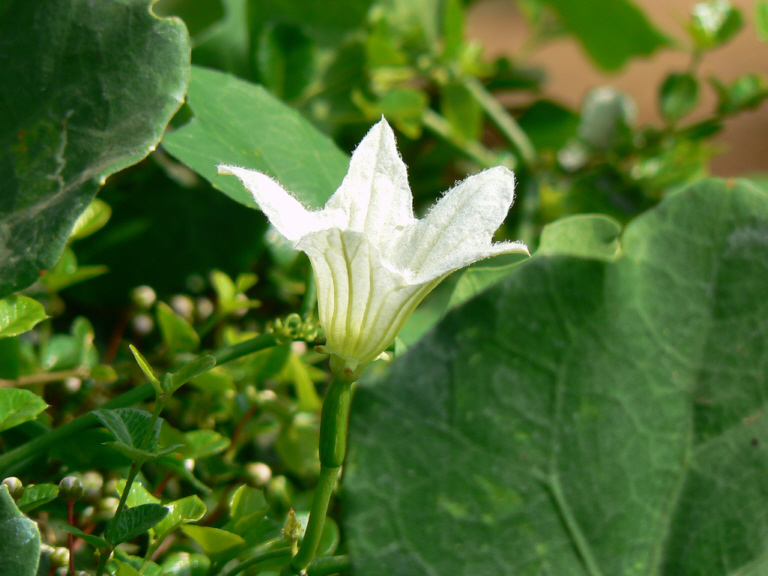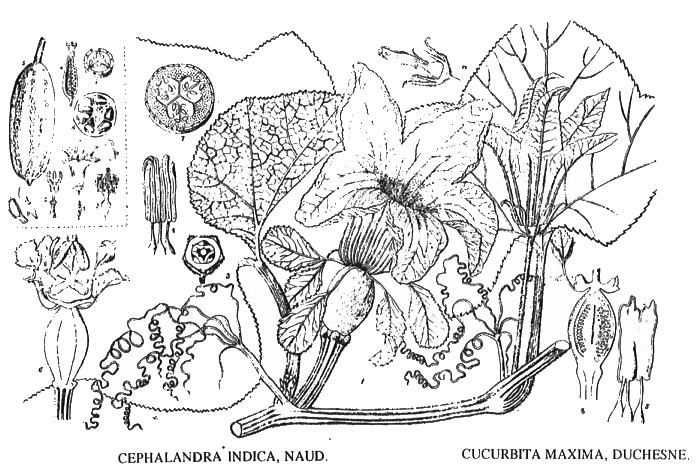

Zitierweise / cite as:
Carakasaṃhitā: Ausgewählte Texte aus der Carakasaṃhitā / übersetzt und erläutert von Alois Payer <1944 - >. -- Anhang A: Pflanzenbeschreibungen. -- Coccinia grandis (L.) Voigt -- Fassung vom 2007-06-29. -- URL: http://www.payer.de/ayurveda/pflanzen/coccinia_grandis.htm
Erstmals publiziert: 2007-03-19
Überarbeitungen: 2007-06-29 [Ergänzungen]; 2007-05-10 [Ergänzungen]
Anlass: Lehrveranstaltung SS 2007
©opyright: Dieser Text steht der Allgemeinheit zur Verfügung. Eine Verwertung in Publikationen, die über übliche Zitate hinausgeht, bedarf der ausdrücklichen Genehmigung des Verfassers
Dieser Text ist Teil der Abteilung Sanskrit von Tüpfli's Global Village Library
WARNUNG: dies ist der Versuch einer
Übersetzung und Interpretation eines altindischen Textes. Es ist keine
medizinische Anleitung. Vor dem Gebrauch aller hier genannten Heilmittel wird
darum ausdrücklich gewarnt. Nur ein erfahrener, gut ausgebildeter ayurvedischer
Arzt kann Verschreibungen und Behandlungen machen!
Falls Sie die diakritischen Zeichen nicht dargestellt bekommen, installieren Sie eine Schrift mit Diakritika wie z.B. Tahoma.
Verwendete und zitierte Werke siehe: http://www.payer.de/ayurveda/caraka0001.htm

Abb.: Coccinia indica W & A.
[Bildquelle:
dinesh_valke. --
http://www.flickr.com/photos/dinesh_valke/423970109/. -- Zugriff am
2007-06-29. --
![]()
![]()
![]() Creative
Commons Lizenz (Namensnennung, keine kommerzielle Nutzung, keine
Bearbeitung)]
Creative
Commons Lizenz (Namensnennung, keine kommerzielle Nutzung, keine
Bearbeitung)]

Abb.: Coccinia indica W & A.
[Bildquelle: Kirtikar-Basu, ©1918]
Dutt:
"COCCINIA INDICA, W. & A. Syn. Momordica monodelpha, Roxb.
Sans. Bimba
Vern. Telākttchā, Beng.The expressed juice of the thick tap-root of this plant is used by the leading native Kavirājas of Calcutta, as an adjunct to the metallic preparations prescribed by them in diabetes. I have not found this use of the plant noticed in any written work, but I know several patients who have taken the juice of the root along with Vangeswara or Somanātha rasa and who were benefited by the use of these remedies. I am inclined to think that the juice of the root of this plant probably acts beneficially in some way. It is very desirable that its therapeutic action should be tested. The expressed juice is directed to be taken in doses of one tolā along with a pill, every morning."
[Quelle: Dutt, Uday Chand: The materia medica of the Hindus / Uday Chand Dutt. With a glossary of Indian plants by George King. -- 2. ed. with additions and alterations / by Binod Lall Sen & Ashutosh Sen. -- Calcutta, 1900. - XVIII, 356 S. -- S. 171.]